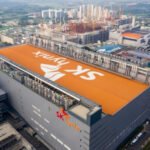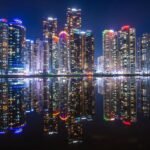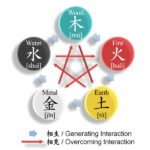Ancient Beginnings: The Founding of Seoul
The city of Seoul, known today as the vibrant capital of South Korea, has ancient roots that trace back to the Three Kingdoms period of Korea, specifically the kingdoms of Baekje and Silla. Evidence suggests that Seoul was originally established as a settlement given its strategic geographical advantages. Nestled within the Han River basin, the location offered natural fortifications and abundant resources, which were significant for early inhabitants engaged in agriculture and trade.
Baekje, founded in 18 B.C.E., recognized the importance of this area, utilizing it as a vital trade route that connected inland regions with the coastal areas. This trade facilitated the exchange of goods between different kingdoms and even with neighboring nations, enhancing both cultural and economic development. The establishment of settlements along the Han River, particularly around modern-day Seoul, allowed for the growth of thriving marketplaces, enabling the development of crafts and the distribution of agricultural products.
During the same period, Silla, the kingdom rivaling Baekje, also laid claim to the surrounding regions, fostering competition for influence and control over these lucrative trade routes. As a consequence, this rivalry propelled advancements in governance and military organization, with both kingdoms striving to enhance their respective infrastructures to support trade and secure their territories. Over time, as these kingdoms evolved, the settlement in Seoul transitioned from a small trade outpost to a region of significant political and military importance.
The early history of Seoul is illustrative of the ways in which geographical advantages shaped its growth and development. The city’s establishment during the Three Kingdoms period marked not just a response to its immediate environment, but also foreshadowed its emergence as a central hub for commerce, culture, and governance for centuries to come.
The Joseon Dynasty: Seoul as the Capital
The Joseon Dynasty, which ruled Korea from 1392 to 1910, played a pivotal role in transforming Seoul into a prominent capital city, known then as Hanyang. Established by Yi Seong-gye, the dynasty sought to create a new center of power, moving the capital from Kaesong to Hanyang in 1394. This strategic relocation was not merely political; it marked the beginning of a profound cultural and social evolution in the region that would establish a lasting identity for Seoul.
During the Joseon period, significant developments transpired that contributed to Seoul’s evolution. The construction of iconic palaces such as Gyeongbokgung and Changdeokgung exemplified the architectural advancements of the era and their alignment with Confucian ideals. These structures represented not only royal power but also a space for governance and societal order, reflecting the emphasis on Confucianism as a guiding philosophy. The impact of Confucianism on the societal norms of the time was profound; it shaped education, family structures, and governance, reinforcing moral conduct and hierarchical relationships within communities.
Moreover, the dynasty facilitated cultural advancements in various fields, including literature, art, and science. The establishment of institutions such as the Royal Academy of Learning promoted scholarly pursuits and significantly contributed to the intellectual landscape of Seoul. This period saw the flourishing of Korean literature, with notable figures emerging and producing works that mirrored the society’s values. Additionally, advancements in technology and agriculture helped to bolster the city’s economy, making Seoul an essential hub of trade and culture.
Thus, the Joseon Dynasty’s influence on Seoul was profound and multifaceted, establishing it as a vital cultural and political center rooted in Confucian values. This foundation would resonate throughout the following centuries, shaping not only the capital’s identity but also the entirety of Korean society.
Colonial Era: Challenges and Changes
The Japanese occupation of Korea from 1910 to 1945 marked a significant transformation in the landscape and socio-cultural fabric of Seoul. During this period, the occupying forces implemented rigorous policies aimed at suppressing Korean identity and culture. The cultural oppression was manifested through the forced adoption of the Japanese language, suppression of native cultural expressions, and the promotion of Shintoism, reflecting the colonial objective of erasing Korean heritage. Traditional Korean customs and practices faced immense challenges as schools integrated Japanese curricula, stifling the growth of local identity.
Seoul, the heart of Korea, underwent extensive infrastructural changes under Japanese rule. The colonial government sought to modernize the city to facilitate control and efficient governance. This included the construction of new roads, bridges, and railway systems that were designed to connect Seoul with other major cities for economic exploitation. However, while these developments provided some benefits, they largely served the interests of the colonial administration, often sidelining the needs of the local populace. Furthermore, the introduction of urban planning initiatives altered the layout of Seoul, creating a stark division between affluent Japanese districts and impoverished Korean neighborhoods.
Resistance movements also emerged during the occupation, as Koreans sought to reclaim their national identity and rights. Organizations such as the Korean National Association and the March 1st Movement played pivotal roles in advocating for independence. These movements often faced harsh repercussions from the Japanese authorities, which led to a cycle of violent clashes and repression. Despite the challenges presented during this tumultuous era, these acts of resistance became emblematic of the resilience of the Korean spirit and ultimately contributed to the shaping of modern perceptions of Seoul. The legacy of this period continues to influence contemporary discourse around national identity and collective memory in South Korea.
Post-War Reconstruction: Rising from the Ashes
The Korean War, which lasted from 1950 to 1953, left Seoul in a state of devastation, with significant damage to infrastructure, economy, and public morale. In the years that followed, the people of South Korea, particularly those in Seoul, faced the monumental task of rebuilding their lives and city. The post-war reconstruction phase was characterized by a series of initiatives aimed at revitalizing the urban landscape and stimulating economic recovery.
Beginning in the late 1950s and gaining momentum in the 1960s, the South Korean government implemented various plans that focused on industrialization and modernization. This period marked the foundation of what would later be known as the “Miracle on the Han River.” Key policies promoting economic development included land reforms, investment in infrastructure, and the encouragement of foreign investment. The establishment of special economic zones served as a catalyst for growth, attracting both local businesses and international corporations looking to leverage the developing market.
Alongside economic policies, urbanization became a pivotal factor in Seoul’s transformation. The population swelled as individuals migrated from rural areas in search of better opportunities, pressuring the city to expand and innovate its housing and transportation systems. Notably, the government initiated large-scale construction projects, resulting in the development of key economic districts such as Gangnam, which emerged as a bustling hub for commerce and finance.
The 1980s and 1990s marked further consolidation of Seoul’s position as a modern metropolis. The city embraced globalization, enhancing its infrastructure, transportation networks, and technology sectors. The steady rise in economic power not only improved the quality of life for many citizens but also established Seoul as a vital player on the international stage. The post-war years ultimately laid the groundwork for extraordinary advancements, shaping Seoul into a dynamic urban area recognized worldwide for its resilience and innovation.
Seoul in the 21st Century: A Global City
In the 21st century, Seoul has transformed significantly into a global city, becoming a hub of innovation, culture, and international business. Multiple factors have contributed to this evolution, enabling the South Korean capital to establish its presence on the world stage. Technological advancements have played a fundamental role, with Seoul emerging as a leader in ICT (Information and Communications Technology), smart city initiatives, and large-scale infrastructure projects. This focus on technology has enhanced not only the efficiency of urban management but also the overall quality of life for its residents.
Moreover, the rise of K-pop has substantially influenced Seoul’s global image. The genre has transcended borders, attracting a devoted international fanbase and garnering significant economic benefits for the city. The influence of K-pop has spurred other cultural exports, such as Korean cinema and cuisine, which have further solidified Seoul’s position as a cultural powerhouse. This vibrant cultural landscape has attracted millions of tourists each year, contributing to the city’s economy and promoting a diverse cultural exchange.
Seoul’s emergence as a global financial center cannot be overlooked either. As a city that is hosting numerous multinational corporations and financial institutions, it has become an essential player in international markets and politics. This development has fostered global economic connections, further showcasing Seoul’s importance on a worldwide platform.
However, the rapid growth and globalization of Seoul have also led to urban challenges, including population density and environmental concerns such as pollution. These issues present significant hurdles that the city must navigate as it strives to maintain its status as a leading global city. Addressing these challenges while sustaining its cultural and economic vibrancy remains imperative for Seoul’s future trajectory. In conclusion, the interplay of technology, culture, and commerce continues to shape Seoul as a dynamic global city in the 21st century.
Cultural Heritage: Balancing Tradition and Modernity
Seoul, as the capital city of South Korea, serves as a remarkable case study of how a metropolis can successfully navigate the delicate balance between preserving cultural heritage and embracing modernity. This dynamic interplay is evident in the city’s rich tapestry of historical sites, contemporary architecture, and vibrant cultural festivals. One of the most prominent historical landmarks is Gyeongbokgung Palace, which dates back to the 14th century. The palace has undergone various restorations to maintain its architectural integrity while also serving as a symbol of Korea’s regal past.
In addition to grand palaces, Seoul is home to numerous museums that offer insights into the city’s cultural and historical legacy, such as the National Museum of Korea and the Seoul Museum of Art. These institutions not only preserve artifacts reflecting Korea’s rich history but also provide educational programs that connect traditional culture with modern artistic expressions. This dual focus encourages residents and visitors alike to appreciate the evolution of Korean identity through the centuries.
The city’s approach to festivals further illustrates this commitment to cultural preservation amidst modern development. Events such as the Seoul Lantern Festival and the Seoul Kimchi Making & Sharing Festival highlight traditional practices while engaging the community in contemporary ways. By incorporating historical customs into modern contexts, these festivals allow residents to celebrate their heritage while forging new identities in a rapidly changing city.
However, public perception regarding the preservation of heritage sites versus the encroachment of contemporary architectural developments can be contentious. Some city residents advocate for the conservation of historical sites as essential components of cultural identity. Conversely, others support modern constructions that reflect the city’s status as a global metropolis. This ongoing dialogue indicates that while Seoul embraces modernity, it remains deeply aware of its roots, striving to create a balanced urban environment that respects both tradition and innovation.
Sustainability and Urban Development: A Vision for the Future
Seoul, the capital city of South Korea, has embarked on a transformative journey that reflects a strong commitment to sustainability and smart urban development. As urbanization progresses, the city recognizes the necessity of adapting its infrastructure and policies to mitigate the impacts of climate change, improve the quality of life for residents, and create a more sustainable future. Central to this vision is the integration of green spaces within the urban landscape, providing residents with accessible parks and recreational areas that promote well-being and biodiversity.
One key initiative is the ongoing effort to reduce carbon emissions throughout the metropolitan area. The city government has set ambitious targets, aiming for a significant decrease in greenhouse gas emissions by embracing renewable energy sources, enhancing energy efficiency in buildings, and encouraging the use of public transportation. Such initiatives not only contribute to environmental sustainability but also enhance the urban infrastructure that supports economic growth and social cohesion.
In tandem with reducing emissions, Seoul’s urban development strategy emphasizes the incorporation of smart technology. This approach allows for real-time data collection and management, optimizing resource use and enhancing the overall efficiency of city services. Smart traffic management systems, for instance, help alleviate congestion, reduce travel times, and lower emissions. Additionally, the introduction of smart grids facilitates better energy management, allowing households and businesses to monitor consumption patterns and adopt more sustainable practices.
Collaboration between the local government and residents is pivotal in shaping a sustainable urban environment. Community engagement initiatives, such as participatory planning and local sustainability programs, encourage citizens to take an active role in decision-making. These partnerships foster a sense of ownership and responsibility toward the ecological well-being of the city. As Seoul progresses into the future, the synergy between sustainability efforts, smart technology, and community involvement will be essential in realizing its vision as a modern metropolis that prioritizes environmental stewardship and livability.
Challenges Ahead: Socio-Economic Issues and Inequality
While Seoul exemplifies rapid modernization and urban growth, it faces significant socio-economic challenges that must be addressed if it is to sustain its development. One of the most pressing issues is housing affordability. As the population continues to swell in the metropolitan area, housing prices have surged, leading to an increasingly difficult situation for lower- and middle-income residents. The disparity in housing costs relative to income has engendered a notable divide, compelling many to seek accommodation in the periphery or even in less desirable conditions. This phenomenon raises critical questions regarding urban policy and the provision of affordable housing solutions.
Another concern is youth unemployment, which remains a focal point of societal strain. Despite the robust economic landscape, many young individuals struggle to secure stable jobs that reflect their education and skills. The competitive job market often sidelines recent graduates, invoking feelings of disenchantment and frustration among the youth. This situation not only affects individual livelihoods but also has broader implications for economic growth and social stability. Addressing youth unemployment requires a comprehensive approach that includes upskilling initiatives and new employment opportunities in emerging sectors.
Social inequality further exacerbates these challenges. A notable gap exists between affluent and marginalized communities, affecting access to critical resources such as education, healthcare, and employment opportunities. Current policies aimed at bridging this divide have been met with mixed reactions, revealing a public sentiment laden with both hope and skepticism. To tackle these socio-economic issues effectively, Seoul’s leadership must engage in strategic planning that prioritizes inclusiveness and equitable resource distribution. Such measures are crucial for fostering a more balanced urban environment that caters to its diverse population, ensuring a sustainable future for all residents.
Vision 2030 and Beyond: The Future of Seoul
As Seoul strides further into the 21st century, it embraces ambitious plans that envision a transformative urban future by the year 2030. Central to these initiatives is the city’s commitment to integration of smart technologies and enhanced infrastructure. By leveraging innovations such as artificial intelligence and the Internet of Things, Seoul aims to build a more efficient, interconnected urban ecosystem. The Smart City initiative showcases efforts to streamline services from transportation to energy management, directly benefiting residents through improved quality of life.
Demographic trends also play a crucial role in shaping Seoul’s future. With a declining birth rate and aging population, the city faces unique challenges in maintaining a vibrant economy and dynamic society. In response, planners are focusing on policies that encourage work-life balance, gender equality, and family-friendly environments. Moreover, attracting international talent, especially younger populations, has become a priority as Seoul seeks to enhance its cultural fabric and global standing.
However, the specter of global warming is ever-present, demanding proactive environmental strategies. Initiatives aimed at reducing carbon emissions and enhancing green spaces are at the forefront of the city’s planning. Urban reforestation projects and sustainable public transportation systems are designed to mitigate the effects of climate change while preserving Seoul’s natural beauty. These changes will not only address ecological concerns but also revitalize community interaction through accessible public parks and recreational areas.
In terms of cultural identity, Seoul’s evolution will likely reflect a blend of tradition and modernity. As the city becomes increasingly cosmopolitan, it remains keen on preserving its rich heritage while embracing contemporary influences. The duality of its identity is poised to foster a unique cultural scene that honors its past while welcoming innovative expressions, thereby ensuring Seoul continues to redefine itself for generations to come.















